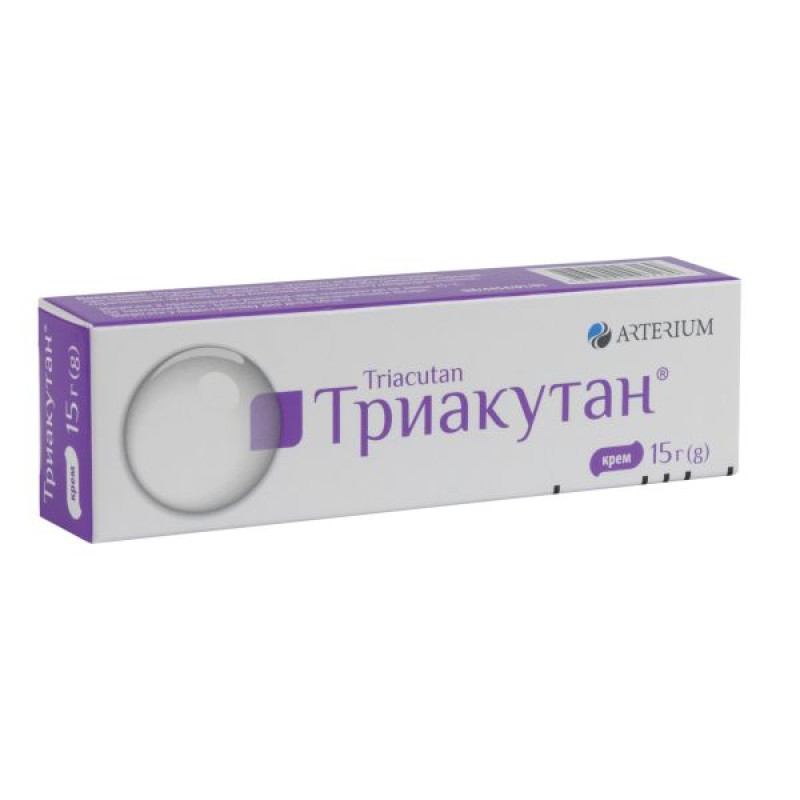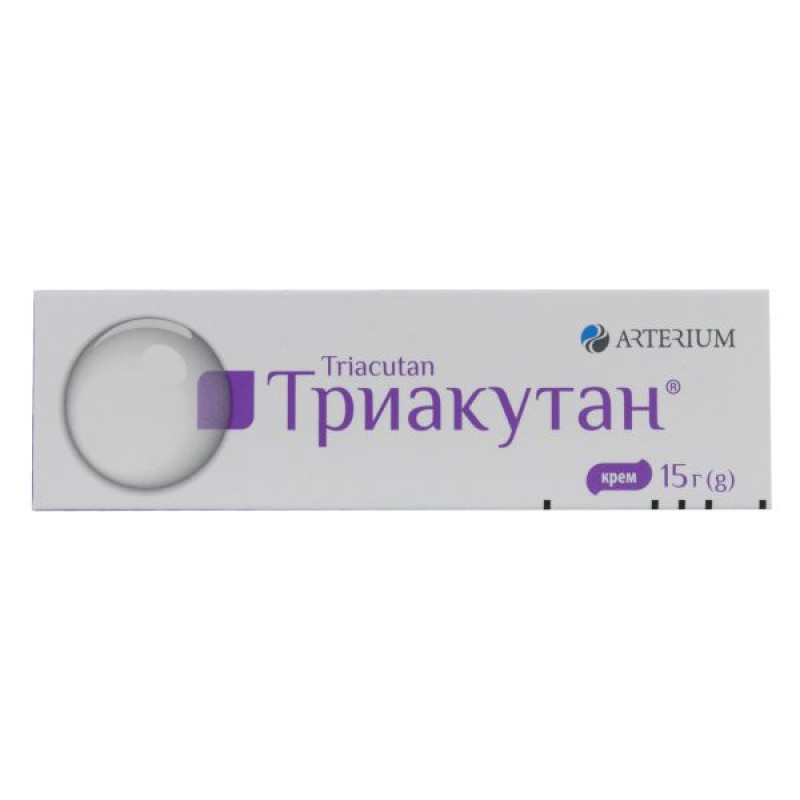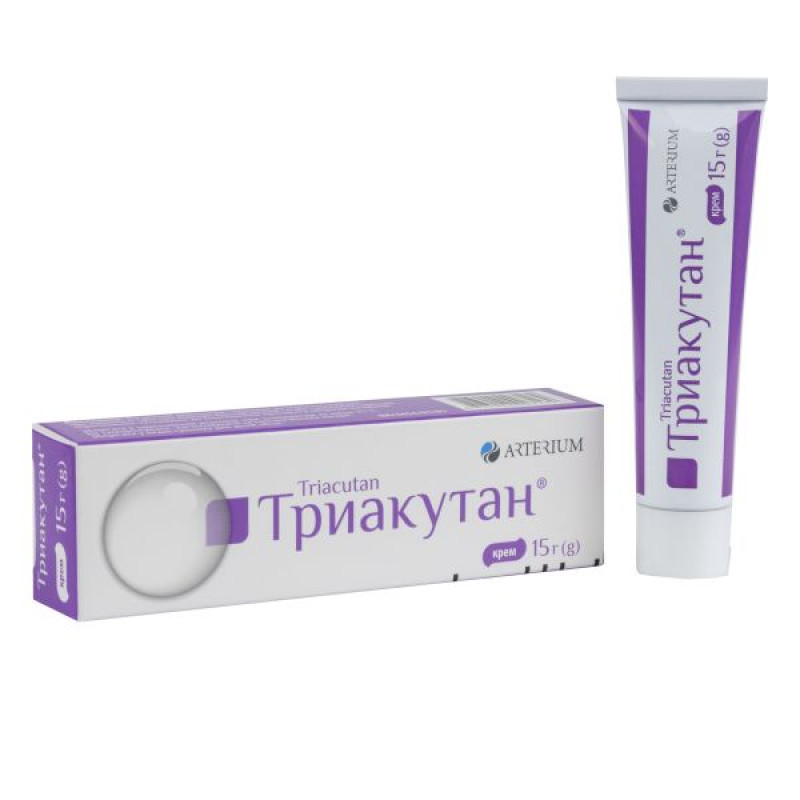Triaccutane cream tube 15 g

Instructions Triakutan cream tube 15 g
Composition
active ingredients: 1 g of cream contains: betamethasone dipropionate* – 0.64 mg; gentamicin sulfate in terms of gentamicin** – 1 mg; clotrimazole*** – 10 mg;
excipients: methylparaben (methyl parahydroxybenzoate) (E 218) – 2 mg; propylene glycol; disodium edetate (Trilon B); mineral oil; white soft paraffin; cetostearyl alcohol; polyethylene glycol (macrogol) cetostearyl ether; sodium dihydrogen phosphate, monohydrate; sodium hydrogen phosphate, dodecahydrate; purified water.
* – betamethasone dipropionate, calculated as 100% substance;
** - gentamicin sulfate, expressed as gentamicin (expressed as anhydrous gentamicin);
*** - clotrimazole, calculated as 100% substance.
Dosage form
Cream.
Main physicochemical properties: white or almost white cream.
Pharmacotherapeutic group
Corticosteroids for use in dermatology. Corticosteroids in combination with antibiotics. Betamethasone and antibiotics.
ATX code D07C C01.
Pharmacological properties
Pharmacodynamics.
The drug combines the anti-inflammatory effect of betamethasone dipropionate, the antibacterial activity of gentamicin sulfate, and the antimycotic effect of clotrimazole.
Betamethasone dipropionate is a potent (class III) corticosteroid with anti-inflammatory, antiallergic, and antipruritic effects.
Gentamicin is an aminoglycoside antibiotic with bactericidal action. The mechanism of action is to inhibit protein synthesis in microorganisms sensitive to the antibiotic. Gentamicin is active against many aerobic gram-negative and a few gram-positive bacteria. In vitro, gentamicin at a concentration of 1-8 μg/ml inhibits most susceptible strains of Escherichia coli, Haemophilus influenzae, Moraxella lacunata, Neisseria, indole-positive and indole-negative strains of Proteus, Pseudomonas (including most strains of Pseudomonas aeruginosa), Staphylococcus aureus, Staphylococcus epidermidis and Serratia. Different species and strains of the same species may show significant differences in in vitro susceptibility. In addition, in vitro susceptibility does not always correlate with in vivo susceptibility. Gentamicin is ineffective against most anaerobic bacteria, fungi and viruses. Gentamicin is only minimally effective against streptococci.
Resistance to gentamicin can develop in gram-negative and gram-positive bacteria.
Clotrimazole is a synthetic antifungal agent of the imidazole derivative group. The spectrum of sensitivity to clotrimazole includes a number of fungi that are pathogenic to humans and animals. Clotrimazole provides an effective effect against dermatophytes, yeasts and molds. In vitro studies have demonstrated the effectiveness of clotrimazole against Trichophyton rubrum, Trichophyton mentagrophytes, Epidermophyton floccosum, Microsporum canis and Candida (including Candida albicans). It is known that the antifungal effect of clotrimazole is due to inhibition of ergosterol synthesis. Ergosterol is an important component of the cell membrane of fungi.
Pharmacokinetics.
Pharmacokinetic studies of the drug have not been conducted.
Betamethasone. Under normal conditions, only a portion of topically applied betamethasone is systemically available. The extent of penetration depends on the site of application, skin condition, dosage form, patient age, and route of administration.
Gentamicin. Gentamicin is not absorbed after topical application to intact skin, but after application to damaged or inflamed skin and when occlusive dressings are used on small areas of skin, gentamicin may be absorbed systemically.
Clotrimazole: Systemic absorption is low after application to the skin, with most clotrimazole remaining in the stratum corneum. The following concentrations were observed 6 hours after application of 1% radioactive clotrimazole to intact and acutely inflamed skin: stratum corneum = 100 μg/cm³, stratum reticulum = 0.5-1 μg/cm³, subcutaneous layer = 0.1 μg/cm³.
Indication
Treatment of dermatoses sensitive to corticosteroids in the presence (or suspicion) of bacterial and/or fungal infections caused by microorganisms sensitive to the components of the drug.
Contraindication
The drug is contraindicated in patients with hypersensitivity to the active substances or to any other component of the drug, to other aminoglycoside antibiotics (cross-allergic reactions to gentamicin) or imidazole derivatives (cross-allergic reactions to clotrimazole). As well as in skin tuberculosis, skin manifestations of syphilis, skin reactions after vaccination, skin ulcers, acne, widespread plaque psoriasis, viral skin infections (e.g. herpes simplex, shingles), varicose veins, perioral dermatitis, acne rosacea, chickenpox, other bacterial and fungal skin infections without adequate antibacterial and antifungal therapy.
The drug is not indicated for use under occlusive dressings. The drug should not be applied to mucous membranes, eyes or the area around the eyes.
Do not use the cream to treat nail or scalp infections.
Interaction with other medicinal products and other types of interactions
When applying the cream to the skin of the genitals and anus, the presence of soft paraffin (an excipient in the composition of the drug) may reduce the tensile strength of latex condoms, thereby reducing their reliability during use. Clotrimazole, when applied topically, may be an antagonist of amphotericin and other polyene antibiotics.
Application features
The cream is particularly suitable for use in the treatment of disorders in the exudative stage. The drug is not intended for use in ophthalmology.
In the event of skin irritation or hypersensitivity during treatment with the cream, the use of the drug should be discontinued and adequate therapy should be selected for the patient.
When applied topically, systemic absorption of active substances may be higher when the drug is applied to large areas of skin, especially with prolonged use or when applied to damaged skin areas. In this case, side effects observed after systemic use of active substances may occur.
With simultaneous systemic administration of aminoglycoside antibiotics, the possibility of cumulative toxic effects (ototoxicity/nephrotoxicity) should be taken into account.
In particular, cross-allergic reactions with other aminoglycoside antibiotics should be borne in mind.
Prolonged topical use of antibiotics may sometimes lead to the growth of resistant microflora. In this case, as well as in the event of the development of superinfection, drug therapy should be discontinued and appropriate treatment should be prescribed.
Corticosteroids with high potency on large areas of skin should be used with careful periodic monitoring because they may suppress the function of the hypothalamic-pituitary-adrenal (HPA) axis. If suppression develops, the drug should be discontinued, the frequency of application reduced, or the patient transferred to a less potent corticosteroid. HPA function usually recovers when the drug is discontinued. In isolated cases, withdrawal symptoms may develop, requiring the addition of a systemic corticosteroid.
Avoid applying the drug to open wounds or damaged skin.
Continuous treatment for more than 2-3 weeks is not recommended.
Very potent, potent, and moderate-potency corticosteroids should be used with caution when applied to the face and genitals. In such cases, the course of treatment should not exceed 1 week.
In general, only low-dose corticosteroids should be used in the area around the eyes (glaucoma).
Corticosteroids may mask the symptoms of an allergic reaction to one of the components of the drug.
The patient should be instructed to use the drug only for individual treatment and not to share it with other persons.
Use during pregnancy or breastfeeding
Pregnancy.
Experimental studies have shown teratogenic effects of topical corticosteroids. There are no data on their use in pregnant women.
Aminoglycosides cross the placental barrier and may cause fetal harm when administered to pregnant women. There have been reports of complete irreversible bilateral congenital deafness in children whose mothers received aminoglycosides (including gentamicin) during pregnancy. There are insufficient data on the use of topical gentamicin in pregnant women. There are insufficient data on the use of clotrimazole in pregnant women.
Animal studies have not demonstrated a risk of exposure to the drug on the fetus.
Triacutan® should be used during pregnancy only if absolutely necessary. Triacutan® should not be used in large doses, on large areas of skin, for long periods of time, or under occlusive dressings.
Lactation.
It is not known whether gentamicin, clotrimazole and corticosteroids can penetrate into breast milk when applied topically. However, systemic corticosteroids are found in breast milk, therefore, during treatment with Triacutan, breastfeeding should be discontinued.
The drug should not be applied to the mammary glands of women who are breastfeeding.
The drug should not be used in the first trimester of pregnancy.
The drug can only be prescribed in later stages of pregnancy if the expected benefit to the expectant mother outweighs the potential risk to the fetus.
Ability to influence reaction speed when driving vehicles or other mechanisms
The effect on the ability to drive or operate other automated systems has not been studied.
Method of administration and doses
Adults should apply a thin layer of the drug to the entire affected surface and adjacent intact skin 2 times a day, morning and evening. The duration of treatment depends on the patient's clinical response to treatment, as well as clinical and microbiological indicators.
In the case of athlete's foot, a longer course of treatment (2-4 weeks) may be necessary.
Children
It is not recommended for use in children, as there is no experience with the use of the drug in patients of this age category.
Overdose
With prolonged or excessive use of local glucocorticosteroids, suppression of the pituitary-adrenal system is possible with the development of secondary adrenal insufficiency and the appearance of symptoms of hypercorticism, including Cushing's disease.
It should not be excluded that a single overdose of gentamicin leads to the appearance of overdose symptoms.
Excessive and prolonged topical use of gentamicin may lead to overgrowth of microorganisms insensitive to the antibiotic.
Treatment. Administer appropriate symptomatic therapy. Symptoms of acute hypercorticism are usually reversible. If necessary, electrolyte balance should be corrected. In case of chronic toxicity, withdrawal of corticosteroids should be gradual.
In case of overgrowth of resistant microorganisms, it is recommended to discontinue treatment with the drug and prescribe the necessary antifungal or antibacterial therapy.
Adverse reactions
Starting treatment
From the skin side
Rare: skin irritation, burning sensation, itching, dry skin, hypersensitivity reactions to one of the components of the drug and skin discoloration.
When applied to large areas of skin, under occlusive dressings and/or for a long time, local skin changes may occur. When applied to large areas of skin, systemic reactions (adrenal suppression, fainting, hypotension, shortness of breath, discomfort/pain, malaise) may occur.
It is important to remember the increased risk of developing secondary infections due to reduced local resistance to infection.
Localized skin changes may occur, such as skin atrophy (more common when used on the face), telangiectasia, exudation, blistering, edema, urticaria, skin maceration, sweating, hypochromia, striae, focal skin peeling, skin tingling, skin flaking, skin induration, skin cracking, feeling of warmth, follicular rash, erythema, stretch marks, subcutaneous hemorrhages, purpura, steroid acneiform eruptions, rosacea-like/perioral dermatitis, hypertrichosis, and skin discoloration (including hypopigmentation). It is not known whether skin discoloration is reversible.
Uncommon: contact sensitization to gentamicin.
Possible photosensitization was observed in some patients; however, this effect was not reproduced by repeated administration of gentamicin followed by exposure to ultraviolet radiation.
On the part of the endocrine system: inhibition of the synthesis of endogenous corticosteroids, excessive adrenal activity with edema. Any side effects observed with systemic use of glucocorticoids, including suppression of the adrenal cortex, may also occur with their local use.
Metabolic: development of latent diabetes mellitus.
On the part of the auditory organs, inner ear/on the part of the kidneys: with simultaneous systemic use of aminoglycoside antibiotics, cumulative ototoxicity/nephrotoxicity may occur when applying Triacutan® cream to large areas of skin or to damaged skin.
From the musculoskeletal system: osteoporosis, growth retardation (in children).
Cetostearyl ether, which is part of the medicinal product, may cause local limited skin reactions (e.g. contact dermatitis).
Expiration date
3 years.
Storage conditions
Store in original packaging at a temperature not exceeding 25 ° C. Do not freeze.
Keep out of reach of children.
Packaging
15 g in a tube; 1 tube in a pack.
Vacation category
According to the recipe.
Producer
PJSC "Kyivmedpreparat".
Location of the manufacturer and its business address
Ukraine, 01032, Kyiv, Saksaganskoho St., 139.
There are no reviews for this product.
There are no reviews for this product, be the first to leave your review.
No questions about this product, be the first and ask your question.








